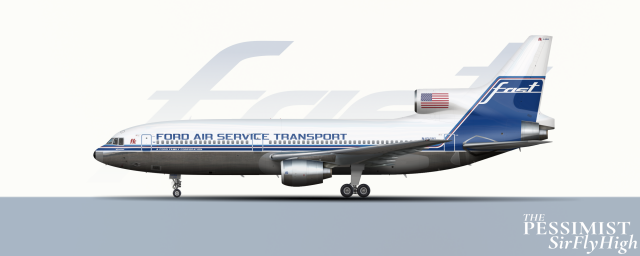
1975 Lockheed L1011-500
- Owner: ThePessimist (View all images and albums)
- Uploaded: Jan 13 2023 05:15 AM
- Views: 1,327
- Album Valiant Airways

FAST management marched towards the 70s with an eye towards expanding their long-haul presence. Since the introduction of the 707 and its variants, the carrier’s overseas routes had languished without really much of a chance for upgrades. However, this changed when whispers of a massive new Boeing jet began to spill out of Everett. In 1966, the first orders for Boeing’s new 747 were placed and Valiant joined the line of carriers eager to try out the new supersized jet. The size and range of the aircraft could revolutionise international travel from both a convenience and comfort standpoint.
March 7, 1970’s service of VL 101, direct from Detroit to Paris, constituted the carrier’s first revenue operations with the 747-100. A star studded cast of FFC executives and politicians said that the size and power of the new “jumbo jet” were a testament to the excellence of American engineering and fabrication. Despite their public support of the program and aggressive campaign to get the 747 in the air flying in FAST colours, some management feared that an aircraft as big as the 747 would be hard to consistently fill. Thus, FAST’s initial order for 747s was only for 4 of the -100. This was so that FAST would not be married to the program if it indeed became obvious that the line was uneconomical. The first 747-100s proved to reliably mediocre profit makers but proponents of the program argued that the increased range of the 747-200 would increase the profitability of the line. Thus, an additional 7 747-200s joined the fleet between 1973 and 1975. However, despite their increased range allowing for longer distance routes previously inaccessible to FAST, like Detroit to Tokyo, it still proved to be quite a hassle to keep the aircraft full. However, the range and larger nature of the aircraft did prove to be attractive – the problem was just that FAST needed a plane that wasn’t quite so large.
Thus, even before the first 747 rolled off the production line, FAST approached their friends and Boeing, former partners at Douglas, and original allies at Lockheed asking all three corporations to produce a jet smaller than the 747 that achieved similar range. FAST predicted that an aircraft seating around 275 persons would be ideal for thinner connections they wished to operate with widebodies, such as Detroit to Dublin, Jacksonville to Paris, and DC to Milan. This aircraft, they reasoned, would play an important role in the future fleet plans of the airline. Even though Douglas’s answer to this call, the DC-10, offered reliable P&W powerplants and neither FAST nor Valiant had operated a Lockheed built aircraft in nearly 50 years, FAST was intrigued by the technological advancement of the Tristar and the prospect of forming a close partnership with a new(ish) manufacturer. Thus, in a blockbuster deal, FAST ordered 50 of the new L1011-1 in what was at the time the most expensive single aircraft purchase in American history. This reflected a common 70s and 80s trend where FFC would fully finance any major purchase that FAST requested if it had a good profit projection. The corporation sat on enough capital that it would simply buy aircraft instead of leasing them. This meant that despite its less than dominant size, FAST retained extremely high market valuation just through the value of its assets.
FAST’s apparent confidence in the Tristar program was rewarded by stacking delays to the type mostly due to the financial woes of Britain’s Rolls Royce. RR’s struggles convinced the carrier that sticking with P&W broadly was an ideal strategy. It also led the carrier to consider other widebody options as other carrier rolled out DC-10s and FAST was left without suitable aircraft. However, these orders came to nothing before the L1011-1s arrived starting in 1972. Many of these were later upgraded to longer range spec L1011-250 which allowed them to finally take on the long range rolls for which they were originally envisioned. The carrier bolstered its fleet of Tristars with additional long range L1011-500s which continued to push the limit of how far FAST’s network could reach.
As the carrier struggled with procurement, the branding division struggled in a different corner of FFC’s Detroit offices. FAST’s livery was dated. Even when it had been new, the FAST livery showed its age. This was becoming a problem as FAST wished to boost its prestige and compete for status as one of America’s premiere airlines. Executives drew up a new corporate livery for FAST that preserved the signature FAST wordmark but introduced a shade of red that highlighted that FAST was in fact an American carrier (in case anyone wondered from whence FAST was based). The livery also significantly updated the appearance of the fuselage. The new livery also featured the new FFC wordmark logo which debuted across the FFC line from 1973 to 75 in various colour iterations.
Excellent 10/10
That is one monstrously large US flag.
But yes, she's a pretty one!
Thank you so much! How else would an outside observer tell that this FAST Tristar is American? Truthfully, the flag is big on the engine of this trijet but twin and quads don't get the giga-flag.
Excellent 10/10
Thank you!
Awesome but the large US flag looks odd-bad.

 Sign In
Sign In Create Account
Create Account












That is one monstrously large US flag.
But yes, she's a pretty one!